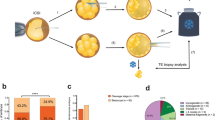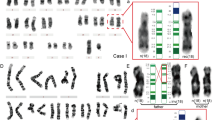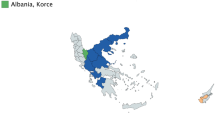Abstract
The cause of non–disjunction of chromosome 21 remains largely unknown. Advanced maternal age is associated with both maternal meiosis I (MI) and meiosis II (MII) non–disjunction events. While reduced genetic recombination has been demonstrated in maternal MI errors, the basis for MII errors remains uncertain. We studied 133 trisomy 21 cases with maternal MII errors to test the hypothesis that segregation at MII may also be influenced by genetic recombination. Our data support a highly significant association: MII non–disjunction involves increased recombination that is largely restricted to proximal 21 q. Thus, while absence of a proximal recombination appears to predispose to non–disjunction in MI, the presence of a proximal exchange predisposes to non–disjunction in MII. These findings profoundly affect our understanding of trisomy 21 as they suggest that virtually all maternal non–disjunction results from events occurring in meioisis I.
This is a preview of subscription content, access via your institution
Access options
Subscribe to this journal
Receive 12 print issues and online access
$209.00 per year
only $17.42 per issue
Buy this article
- Purchase on Springer Link
- Instant access to full article PDF
Prices may be subject to local taxes which are calculated during checkout
Similar content being viewed by others
References
Sherman, S.L. et al. Trisomy 21: Association between reduced recombination and nondisjunction. Am. J. Hum. Genet. 49, 608–620 (1991).
Sherman, S.L. et al. Non-disjunction of chromosome 21 in maternal meiosis I: evidence for a maternal age-dependent mechanism involving reduced recombination. Hum. Mol. Genet. 3, 1529–1535 (1994).
Yoon, P.W. et al. Advanced maternal age and the risk of Down syndrome characterized by the meiotic stage of the chromosomal error: a population-based study. Am. J. Hum. Genet. 58, 628–633 (1996).
Warren, A.C. et al. Evidence for reduced recombination on the nondisjoined chromsome 21 in Down syndrome. Science 237, 652–654 (1987).
Antonarakis, S.E. et al. The meiotic stage of nondisjunction in trisomy 21: determination by using DNA polymorphisms. Am. J. Hum. Genet. 50, 544–550 (1992).
Antonarakis, S.E., Avramopoulos, D., Blouin, J., Talbot, C.C. & Schinzel, A.A. Mitotic errors in somatic cells cause trisomy 21 in about 4.5% of cases and are not associated with advanced maternal age. Nature Genet. 3, 146–150 (1993).
Antonarakis, S.E. & Down Syndrome Colabrative Group. Parental origin of the extra chromosome in trisomy 21 as indicated by analysis of DNA polymorphisms. New Engl. J. Med. 324, 872–876 (1991).
Mikkelsen, M. et al. Epidemiology study of Down's syndrome in Denmark, including family studies of chromosomes and DNA markers. Dev. Brain Dysfunct. 8, 4–12 (1995).
Farnet, C., Padmore, R., Cao, L., Raymond, W., Alani, E., Klecher, N., Mechanisms and Consequences of DNA Damage Processing (eds Freidberg, E. & Hanawatt, P. ) (Alan R. Liss, New York, 1989).
Malone, R.E. & Esposito, R.E. Recombinationless meiosis in Saccharomyces cerevisiae Mol. Cell. Biol. 1, 891–901 (1981).
Roeder, G., Rockmill, B., Engebrecht, J., Thompson, E. & Menees, T. Molecular and Cytogenetic Studies of Non-Disjunction (eds Hassold, T. J. & Epstein, C. J. ) 303–326 (Alan R. Liss, New York, (1989).
Sym, M., Engebrecht, J. & Roeder, G. ZIP1 is a synaptonemal complex protein required for meiotic chromosomal synapsis. Cell 72, 365–378 (1993).
Hawley, R.S., McKim, K.S. & Arbel, T. Meiotic segregation in DrosophilaMelanogaster females: molecules, mechanisms and myths. Annu. Rev. Genet. 27, 281–317 (1993).
Hawley, R.S., Frazier, J. & Rasooly, R. Separation anxiety: the biology of non-disjunction in flies and people. Hum. Mol. Genet. 3, 1521–1528 (1994).
Hassold, T.J., Sherman, S.L., Pettay, D., Page, D.C. & Jacobs, P.A. XY chromosome nondisjunction in man is associated with diminished recombination in the pseudoautosomal region. Am. J. Hum. Genet. 49, 253–260 (1991).
MacDonald, M. et al. The origin of 47,XXY and 47,XXX aneuploidy: heterogeneous mechanisms and role of aberrant recombination. Hum. Mol. Genet. 3, 1365–1371 (1994).
Robinson, W.P. et al. Nondisjunction of choromsome 15: origin and recombination. Am. J. Hum. Genet. 53, 740–751 (1993).
Mascari, M.J. et al. Perturbed recombination of chromosome 15 in PraderWilli patients with maternal disomy. Am. J. Hum. Genet. 53, A260 (1993).
Hassold, T., Merrill, M., Adkins, K., Freeman, S. & Sherman, S. Recombination and maternal age-dependent non-disjunction: molecular studies of trisomy 16. Am. J. Hum. Genet. 57, 867–874 (1995).
Fisher, J.M., Harvey, J.F., Morton, N.E. & Jacobs, P.A. Trisomy 18: studies of the parent and cell division of origin and the effect of aberrant recombination on nondisjunction. Am. J. Hum. Genet. 56, 669–675 (1995).
Lorber, B.J., Grantham, M., Peters, J., Willard, H.F. & Hassold, T.J. Nondisjunction of chromosome 21: comparisons of cytogenetic and molecular studies of the meiotic stage and parent of origin. Am. J. Hum. Genet. 51, 1265–1276 (1992).
Petersen, M.B. et al. Comparative study of microsatellite and cytogenetic markers for detecting the origin of the nondisjoined chromosome 21 in Down syndrome. Am. J. Hum. Genet. 51, 516–525 (1992).
Bridges, C.B. Nondisjunction as proof of the chromosome theory of heredity. Genetics 1, 1–52 (1916).
Hassold, T., Pettay, E., May, K. & Robinson, A. Analysis of non-disjunction in sex chromosome tetrasomy and pentasomy. Hum. Genet. 85, 648–650 (1990).
Miyazaki, W.Y. & Orr-Weaver, T.L. Sister-chromatid cohesion in mitosis and meiosis. Annu. Rev. Genet. 28, 167–187 (1994).
Abruzzo, M. & Hassold, T.J. Etiology of nondisjunction in humans. Envir. Mol. Mut. 25, 38–47 (1995).
Henderson, S.A. & Edwards, R.G. Chiasma frequency and maternal age in mammals. Nature 217, 22–28 (1968).
Hassold, T.E., Kumlin, E., Takaesu, N. & Leppert, M. Determination of the parental origin of sex-chromosome monosomy using restriction fragment length polymorphisms. Am. J. Hum. Genet. 37, 965–972 (1985).
Van Hul, W. et al. A contiguous physical map of the pericentromeric region of chromosome 21q between D21Z1 and D21S13E . Genomics 15, 626–630 (1993).
Jabs, E.W. et al. Alphoid DNA polymorphisms for chromosome 21 can be distinguished from those of chromosome 13 using probes homologous to both. Genomics 9, 141–146 (1991).
Chakravarti, A. & Slaugenhaupt, S.A. Methods for studying recombination on chromosomes that undergo nondisjunction. Genomics 1, 35–42 (1987).
Morton, N.E. et al. A centromere map of the X chromosome from trisomies of maternal origin. Ann. Hum. Genet. 54, 39–47 (1990).
Morton, N.E. & Maclean, C.J. Multilocus recombination frequencies. Genet. Res. 44, 99–108 (1984).
Dausset, J. et al. Centre d'Etude du Polymorphisme Humain (CEPH): Collaborative genetic mapping of the human genome. Genomics 6, 575–577 (1990).
Lander, E.S. & Green, P. Construction of multilocus genetic linkage maps in humans. Proc. Natl. Acad. Sci. USA 84, 2363–2367 (1987).
Morton, N.E. & Andrews, V. MAP, an expert system for multiple pairwise linkage analysis. Ann. Hum. Genet. 53, 263–269 (1989).
Rao, D.C., Morton, N.E., Lindsten, J., Hulten, M. & Yee, S. A mapping function in man. Hum. Hered. 27, 99–104 (1977).
Author information
Authors and Affiliations
Rights and permissions
About this article
Cite this article
Lamb, N., Freeman, S., Savage-Austin, A. et al. Susceptible chiasmate configurations of chromosome 21 predispose to non–disjunction in both maternal meiosis I and meiosis II. Nat Genet 14, 400–405 (1996). https://doi.org/10.1038/ng1296-400
Received:
Accepted:
Issue Date:
DOI: https://doi.org/10.1038/ng1296-400
This article is cited by
-
Population monitoring of trisomy 21: problems and approaches
Molecular Cytogenetics (2023)
-
DNA damage in aging, the stem cell perspective
Human Genetics (2020)
-
Choline metabolic pathway gene polymorphisms and risk for Down syndrome: An association study in a population with folate-homocysteine metabolic impairment
European Journal of Clinical Nutrition (2017)
-
Targeting oocyte maturation to improve fertility in older women
Cell and Tissue Research (2016)
-
Insights into epigenetic landscape of recombination-free regions
Chromosoma (2016)



